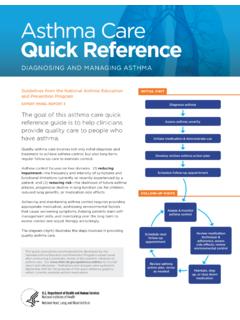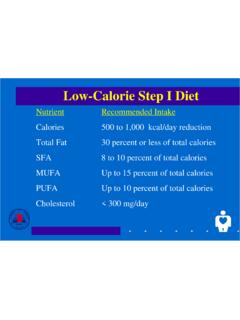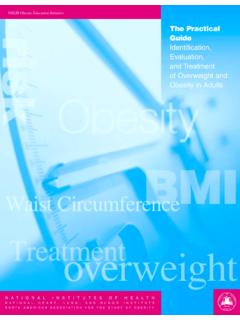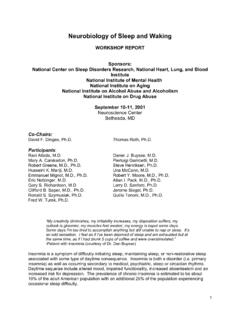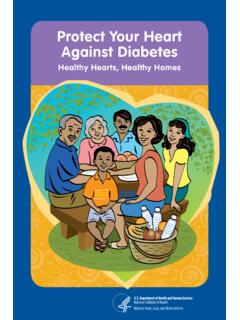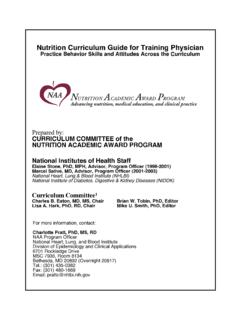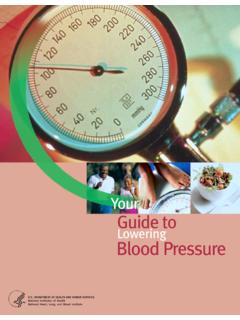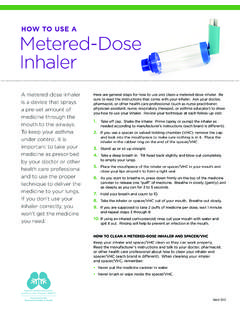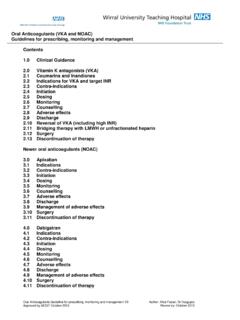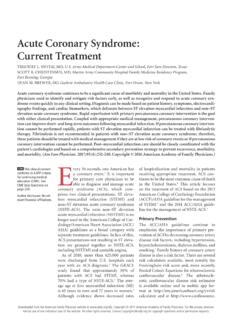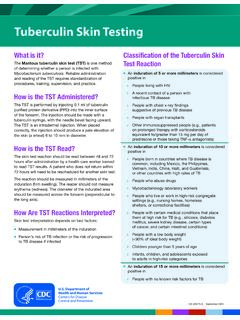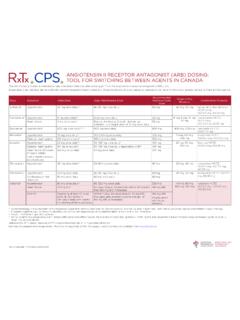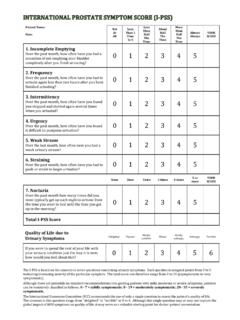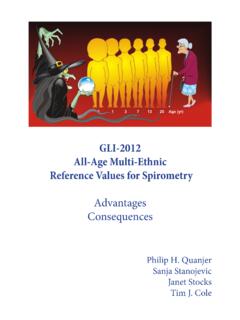Transcription of 2020 Focused Update to the Asthma Management Guidelines
1 2020 Focused Update to the Asthma Management GuidelinesSummary from: A Report from the National Asthma Education and Prevention Program Coordinating Committee Expert Panel Working Group1 Timeline for Asthma Guidelines 2020 Update2 The 2020 Focused Update to the 2007 Asthma Guidelines Six topics were updated: Fractional Exhaled Nitric Oxide (FeNO) in Diagnosis, Medication Selection, and Monitoring Treatment Response in Asthma Remediation of Indoor Allergens ( , Dust Mites) in Asthma Management Immunotherapy and the Management of Asthma Bronchial Thermoplasty(BT)
2 In Adult Severe Asthma Adjustable Inhaled Corticosteroid Dosing in Recurrent Wheezing and Asthma Long-Acting Muscarinic Antagonists in Asthma Management as Add-on to Inhaled Corticosteroids Used GRADE Methodology to assess the certainty of the evidence and strength of recommendations Limited use of Expert Opinion and extrapolation of data across populations or age ranges Addressed pre-specified key questions using the best available evidence3 Other Topics Considered but Not Included in the Update * Prevention of Asthma Biomarkers (other than FeNO) Asthma Severity Classification Biologics Asthma Treatment Plans Role of Community Health Workers4*As determined in the 2014 15 Needs Assessment Asthma Heterogeneity (endotypes and phenotypes) Adherence LABA Safety Step Down from Maintenance TherapyMembers of the Expert Panel Michelle M.
3 Cloutier (Chair) Alan Baptist Kathryn Blake Edward Brooks Tyra Bryant-Stephens Emily DiMango Anne Dixon Kurtis S. Elward Tina Hartert Jerry Krishnan Robert F. Lemanske Daniel R. Ouellette Wilson Pace Michael Schatz Jim Stout Stephen Teach Craig A. Umscheid5 GRADE MethodologyGrading of Recommendations Assessment, Development, and Evaluation (GRADE) An internationally accepted framework to determining the quality or certainty of evidence and the direction and strength of a recommendation Used to review the evidence for patient-important outcomes across studies, to make judgments about certainty of evidence.
4 And to develop recommendations 2 main components to GRADE Evidence Profiles used to determine certainty of evidence based for critical and important outcomes Evidence to Decision Tables used to make final recommendation6 GRADE Methodology4 types of recommendations are possible A recommendation can be for or against an intervention A for or against recommendation can be strong or conditional Implications for individuals and clinicians are shown below7 Strong Recommendation ForConditional Recommendation ForFor individuals with asthmaMost individuals would want this course of action and only a small proportion would individuals in this situation would want the suggested course of action, but many would cliniciansMost individuals should receive the intervention.
5 Different choices will be appropriate for individuals consistent with their values and preferences. Use shared in Asthma ManagementKey Questions Accuracy for diagnosing Asthma in individuals 5 years? Clinical utility of FeNOfor Asthma Management in 5 years? Selecting medications Monitoring treatment effects Monitoring disease activity Accuracy of FeNO in children ages 0 4 years in predicting development of subsequent Asthma ?8 Expert Panel Recommendations: FeNORecommendAs an adjunct in the evaluation process to diagnose Asthma Conditional Recommendation Moderate CertaintyAs part of ongoing Asthma monitoring Conditional Recommendation Low Certainty9 Expert Panel Recommendations.
6 FeNORecommend againstUse in isolation to assess Asthma control, predict future exacerbations, or assess exacerbation severity Strong Recommendation Low CertaintyTo predict the future development of Asthma in children ages 0 4 years Strong Recommendation Low Certainty10 Comments on FeNORecommendationsRole in Asthma diagnosis Use only as an adjunct test if diagnosis uncertainRole in Asthma Management Useful to follow disease activity Useful in medication Management with regular testing Not a stand-alone test to assess control, predict future exacerbations, or assess exacerbation severityImportant considerations Levels affected by a variety of factors (ICS, smoking, age, allergic sensitization) Cut offs need to be refined and validated (in different ethnic groups, in those with comorbidities) Should not be a routine office test in primary care settings without strong specialty support11 Indoor Allergen Mitigation in Asthma ManagementKey Question Effectiveness of interventions to reduce or remove indoor inhalant allergens?
7 12 Expert Panel Recommendations: Allergen Mitigation RecommendIn those with symptoms and/or sensitization and exposure: Multicomponent allergen-specific mitigation Conditional Recommendation Low CertaintyIntegrated pest Management as a single or as part of a multi-component mitigation intervention Conditional Recommendation Low CertaintyImpermeable pillow/mattress covers only as part of a multi-component mitigation intervention Conditional Recommendation Moderate Certainty13 Expert Panel Recommendations: Allergen Mitigation Recommend againstAllergen mitigation in those with no symptoms and/or sensitization related to exposure to a specific allergen as part of routine Asthma Management Conditional Recommendation Low Certainty14 Comments on Allergen Mitigation RecommendationsRequires exposure, with allergy symptoms and/or sensitization Certainty of evidence mostly low Bias, absence of blinding, small sample sizes, imprecision No standardization of outcome measures and interventions (esp.)
8 Multi-component interventions) Harms small apart from cost May distract from other aspects of therapy Interventions may have other public health benefits15 Role of Subcutaneous (SCIT) and Sublingual (SLIT) Immunotherapy in the Treatment of Allergic AsthmaKey Question What is the efficacy and safety of SCIT and SLIT?16 Expert Panel Recommendation:SCIT and SLITin Allergic AsthmaRecommendSCIT as an adjunct to standard pharmacotherapy Conditional Recommendation Moderate CertaintyAdults and children ( 5 years of age)Mild to moderate allergic asthmaAsthma under control at the initiation, build up, and during maintenance of immunotherapy17 Expert Panel Recommendations.
9 SCIT and SLITin Allergic AsthmaRecommend againstSublingual immunotherapy Conditional Recommendation Moderate Certainty18 Comments on Immunotherapy Recommendations SCIT Importance of shared decision-making Benefits of SCIT are small improvements in symptoms and QOL, reduction in long-term medications May improve co-morbid allergic conditions Risk of systemic reactions Optimize control, avoid in severe Asthma , administer in clinical setting SLIT Limited number of allergens have FDA approval, and only for allergic rhinoconjunctivitis May have some benefit in individuals with allergic rhinoconjunctivitisand Asthma Studies show trivial benefit on critical outcomes in Asthma May reduce use of quick relief and controller medication19 Bronchial Thermoplasty (BT) in Asthma ManagementKey Question What are the benefits and harms of using BT in addition to standard treatment for the treatment of adult patients (18 years and older) with Asthma ?
10 20 Expert Panel Recommendation:Bronchial ThermoplastyRecommend againstUse of bronchial thermoplasty Conditional Recommendation Low CertaintyAdults with persistent asthma21 Comments on Bronchial ThermoplastyRecommendation Studies did not include individuals who received LAMA, environmental interventions, and newer biologic agents Optimize medications and address comorbidities before considering BT Carefully consider and discuss risks and benefits with individual patient Adults with persistent Asthma who place a low value on harms (short-term worsening symptoms and unknown long-term side effects) and a high value on potential benefits (improvement in quality of life, a small reduction in exacerbations) might consider BT If BT is performed, should be in context of registries or ongoing clinical trials 22 Medications.
